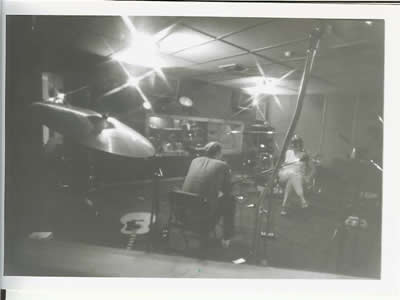Group: Noyes & the Boyes
Recording Period: July 7 and 14, 1984 at Scovil Studios, Norwalk, CT
Mixing Period: March 16 and 17, 1985 at Splice of Life Studios, Brighton, MA
Audrey Ludemann had moved to California with her husband in the Fall of 1979, but returned in May of 1981. She wanted to start playing with Tom and myself again and wanted to do a project. She also wanted to re-record 31June since she hadn’t been part of the Headlands version and liked the song. Eventually we put together much of the October Palace line up, and added Alan Freedman, replacing Dave on bass. This was the first recording work Alan did with us since his “December project” in 1975.
This project became the album, Leftovers and Other Exotic Foods. Harry had moved to Boston just as Audrey was coming back from California, but he came to watch one of the two Saturday sessions and would play a role in the final mixing. Leftovers was a straightforward project with very little overdubbing. We had returned to Scovil Studios for this project, with Gary Scovil engineering both sessions. The musician credits on the album were:
-
Audrey Noyes guitars, vocals
-
Tom May vocals, electric and acoustic guitars
- Greg Smith guitars, vocals, harmonica
- Alan Freedman bass
- Mark Lebow drums
- Ed Flinn congas
In many ways this album was the opposite of Headlands. The sound is more coherent. Recording was limited to a tight pair of sessions. We went in to the studio knowing what songs we’d do. There were no outtakes and no new material (just “leftovers”). The three originals were a retake on 31June, the song Audrey wrote with Harry, Charmer, and Harry and Mark’s Roadside Gardens. This was also the first studio project that included covers of other people’s songs that we particularly loved (“other exotic foods”):
We had largely learned the lesson of “best foot forward.” This album was a showcase for Audrey and especially Tom. Their vocals and his guitar work are very apparent on all of the songs. Tom arranged Jesu Joy of Man’s Desiring for three guitars. This was a substitute for his usual self-composed instrumental. Audrey and I were thrilled to be part of it. (I wouldn’t have been surprised if Tom had announced that he’d play all three parts himself.) Tom also taught us the beautifully understated Julie’s House, a song we still play. He did incredible guitar work on the other six songs. Contrast his leads on Flowers on the Rain and Roll Um Easy. The fluidity of his lead on 31 June still stops me cold. (It’s not quite what he did on the version that appeared on Headlands, but it’s just as good.) It was easy to take Tom’s work for granted; he always delivered.
Audrey was in excellent voice, especially evident in her harmonies. She sings the lead on three out of seven vocals and significant harmonies on the other four. Her guitar and Alan’s bass are the core of our performance on Different for Girls. Her vocals were doubled for Flowers on the Rain.
Between Ed, Alan and Mark the bass/percussion gave the album a good drive, although in retrospect, we all played each song too fast. (I never timed it, but I’ll wager it’s the shortest of our five albums.) We’ve always had this bad habit in our studio work, regardless of who counts off the song.
We made careful notes and a rough mix, but it took eight months for us to get around to properly mixing the album. Harry Hussey found a place for us in Brighton, MA (Splice of Life Studios) and joined us in mixing on a mid-March weekend in 1985. David Zuckerman, the resident engineer, engineered the session and Harry participated along with Mark Lebow and me.
Dave Hopkins and I conceived the cover and Dave shot it at my kitchen table. We made several dozen cassettes of the album.
|
